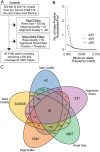Absence of putative artemisinin resistance mutations among Plasmodium falciparum in Sub-Saharan Africa: a molecular epidemiologic study
- PMID: 25180240
- PMCID: PMC4402372
- DOI: 10.1093/infdis/jiu467
Absence of putative artemisinin resistance mutations among Plasmodium falciparum in Sub-Saharan Africa: a molecular epidemiologic study
Abstract
Plasmodium falciparum parasites that are resistant to artemisinins have been detected in Southeast Asia. Resistance is associated with several polymorphisms in the parasite's K13-propeller gene. The molecular epidemiology of these artemisinin resistance genotypes in African parasite populations is unknown. We developed an assay to quantify rare polymorphisms in parasite populations that uses a pooled deep-sequencing approach to score allele frequencies, validated it by evaluating mixtures of laboratory parasite strains, and then used it to screen P. falciparum parasites from >1100 African infections collected since 2002 from 14 sites across sub-Saharan Africa. We found no mutations in African parasite populations that are associated with artemisinin resistance in Southeast Asian parasites. However, we observed 15 coding mutations, including 12 novel mutations, and limited allele sharing between parasite populations, consistent with a large reservoir of naturally occurring K13-propeller variation. Although polymorphisms associated with artemisinin resistance in P. falciparum in Southeast Asia are not prevalent in sub-Saharan Africa, numerous K13-propeller coding polymorphisms circulate in Africa. Although their distributions do not support a widespread selective sweep for an artemisinin-resistant phenotype, the impact of these mutations on artemisinin susceptibility is unknown and will require further characterization. Rapid, scalable molecular surveillance offers a useful adjunct in tracking and containing artemisinin resistance.
Keywords: artemisinin resistance; drug resistance; falciparum malaria; molecular epidemiology.
© The Author 2014. Published by Oxford University Press on behalf of the Infectious Diseases Society of America. All rights reserved. For Permissions, please e-mail: journals.permissions@oup.com.
Figures



Comment in
-
Artemisinin resistance: the more we know, the more complicated it appears.J Infect Dis. 2015 Mar 1;211(5):667-9. doi: 10.1093/infdis/jiu469. Epub 2014 Sep 1. J Infect Dis. 2015. PMID: 25180242 No abstract available.
References
-
- WHO. Geneva: World Health Organization; 2012. World malaria report 2011.
Publication types
MeSH terms
Substances
Grants and funding
- T32GM0088719/GM/NIGMS NIH HHS/United States
- R01 AI099473/AI/NIAID NIH HHS/United States
- K08 AI100924/AI/NIAID NIH HHS/United States
- KL2RR031981/RR/NCRR NIH HHS/United States
- R01AI089819/AI/NIAID NIH HHS/United States
- P30 CA016086/CA/NCI NIH HHS/United States
- R01 AI075045/AI/NIAID NIH HHS/United States
- T32 GM007092/GM/NIGMS NIH HHS/United States
- U19AI089674/AI/NIAID NIH HHS/United States
- R56AI097909/AI/NIAID NIH HHS/United States
- KL2 RR031981/RR/NCRR NIH HHS/United States
- K08AI100924/AI/NIAID NIH HHS/United States
- MC_UP_A900_1118/MRC_/Medical Research Council/United Kingdom
- R01 AI089819/AI/NIAID NIH HHS/United States
- U19 AI089674/AI/NIAID NIH HHS/United States
LinkOut - more resources
Full Text Sources
Other Literature Sources
Research Materials

